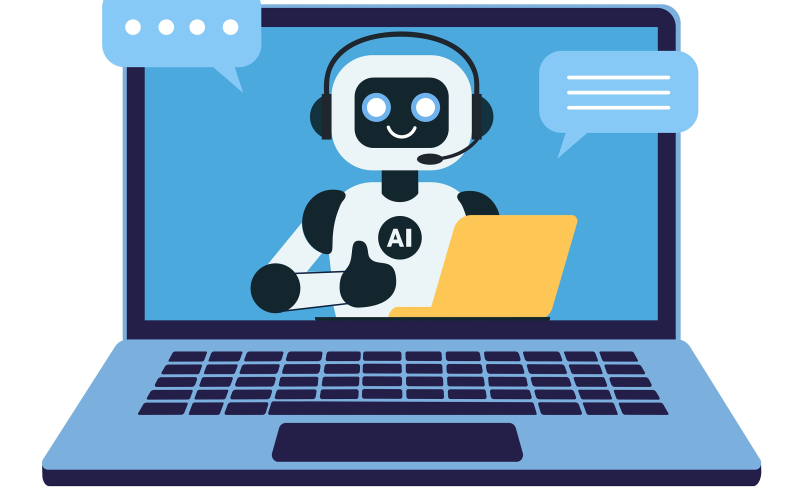
AI Automation: Boosting Business Revenue in 2025
AI Automation: Boosting Business Revenue in 2025
The business landscape is undergoing a profound shift, driven by the increasing capabilities of artificial intelligence. As we approach 2025, the implementation of AI automation tools is no longer a futuristic concept but a present-day necessity for businesses aiming to thrive. These tools present significant opportunities for streamlining processes, enhancing customer interactions, and, most importantly, driving substantial revenue growth. The strategic adoption of AI is poised to redefine how companies operate and compete, with those who embrace it standing to gain a considerable advantage.

Understanding AI Automation
AI automation refers to the use of artificial intelligence to automate tasks and processes that traditionally required human intervention. This encompasses a wide range of applications, from automating routine administrative tasks to complex data analysis and decision-making. Machine learning, natural language processing (NLP), and computer vision are key components of AI automation, enabling systems to learn from data, understand human language, and interpret visual information.
The Current State of AI in Business
Currently, AI is being implemented across various industries, impacting functions like marketing, sales, customer service, and operations. Businesses are utilizing AI-powered chatbots for instant customer support, employing machine learning algorithms to analyze market trends, and using predictive analytics to forecast sales. However, the level of AI integration varies significantly. Some organizations are in the early stages of experimentation, while others have implemented sophisticated AI systems across multiple departments. Reports indicate that businesses are seeing tangible benefits, including increased efficiency, reduced costs, and improved customer satisfaction, but the full potential remains largely untapped.
Relevance in 2025
Looking ahead to 2025, AI is projected to become even more integral to business operations. Advancements in AI technology will lead to more sophisticated and accessible tools, making AI automation more readily available to businesses of all sizes. Furthermore, as data becomes increasingly abundant and processing power continues to grow, AI algorithms will become more accurate and effective. The businesses that proactively adopt and integrate AI into their core strategies will be best positioned to achieve significant gains in revenue and market share. Those that delay risk falling behind, potentially struggling to compete in an AI-driven economy.
How AI Automation Tools Drive Revenue
The impact of AI automation on business revenue is multifaceted. It’s not simply about cutting costs, although that is a benefit. AI tools can generate revenue in several key ways.
Enhancing Productivity through Automation
One of the most direct ways AI boosts revenue is through enhanced productivity. By automating repetitive and time-consuming tasks, AI frees up employees to focus on more strategic and creative work. For example, AI-powered robotic process automation (RPA) can automate data entry, invoice processing, and other back-office functions, reducing errors and improving efficiency. This allows employees to dedicate their time to activities that directly contribute to revenue generation, such as sales, marketing, and product development. A study by McKinsey found that automating routine tasks can increase productivity by as much as 30%.
Optimizing Customer Experience with AI
In today’s competitive market, customer experience is a critical differentiator. AI automation tools can significantly enhance the customer experience by providing personalized, efficient, and seamless interactions. AI-powered chatbots can provide instant support 24/7, addressing customer inquiries and resolving issues quickly and effectively. Machine learning algorithms can analyze customer data to personalize marketing messages, recommend relevant products, and anticipate customer needs. By delivering exceptional customer experiences, businesses can improve customer satisfaction, loyalty, and ultimately, revenue. For instance, companies using AI to personalize customer journeys see a 20% increase in sales on average, according to research from Boston Consulting Group. Furthermore, AI can be used to analyze customer feedback and sentiment, providing valuable insights for improving products and services.
Leveraging Predictive Analytics for Better Decision-Making
Predictive analytics, powered by AI, enables businesses to make more informed decisions based on data-driven insights. By analyzing historical data and identifying patterns, AI algorithms can forecast future trends, predict customer behavior, and assess risks. This information can be used to optimize pricing strategies, improve inventory management, and identify new market opportunities. For example, retailers can use predictive analytics to forecast demand for specific products, ensuring they have adequate inventory to meet customer needs. Financial institutions can use AI to assess credit risk and detect fraudulent transactions. By making better decisions, businesses can improve their efficiency, reduce costs, and increase revenue. A report by Forrester found that businesses that leverage predictive analytics are 2.8 times more likely to achieve revenue growth of 10% or more.
Key AI Tools for Business Growth
Several AI tools are poised to play a pivotal role in driving business revenue in 2025.
Top AI Tools to Watch
- AI-powered CRM: Customer relationship management (CRM) systems enhanced with AI capabilities provide personalized customer experiences and improve sales efficiency. AI can automate lead scoring, identify upsell opportunities, and provide sales representatives with real-time insights into customer needs.
- Predictive Analytics Platforms: These platforms use machine learning algorithms to analyze large datasets and forecast future trends. They can be used for demand forecasting, risk assessment, and market analysis.
- AI Chatbots: Chatbots provide instant customer support and automate routine inquiries. They can be integrated into websites, mobile apps, and messaging platforms.
- Robotic Process Automation (RPA): RPA tools automate repetitive tasks, such as data entry, invoice processing, and report generation. They can be used to improve efficiency and reduce costs in various departments.
- AI-driven Marketing Automation: Automates marketing tasks such as email marketing, social media posting, and ad campaigns. The AI component personalizes content and timing for better engagement.
- Natural Language Processing (NLP) tools: Enables computers to understand and process human language. NLP can be used for sentiment analysis, text summarization, and language translation.
Features and Benefits of Leading AI Tools
Leading AI tools offer a range of features and benefits, including:
- Personalized Customer Experiences: AI algorithms can analyze customer data to provide personalized recommendations, offers, and support.
- Improved Efficiency: AI automation tools can automate repetitive tasks, freeing up employees to focus on more strategic work.
- Data-Driven Decision-Making: Predictive analytics provides insights that enable businesses to make more informed decisions.
- Increased Revenue: By improving customer experience, efficiency, and decision-making, AI tools can drive significant revenue growth.
- Enhanced Scalability: AI systems can easily scale to handle increasing volumes of data and customer interactions.
- Real-time insights: AI allows for dynamic responses based on up-to-the-minute information.
Case Studies of Successful AI Integration
Numerous companies have successfully integrated AI automation tools into their business strategies and achieved significant results.
- Sephora: Uses AI-powered chatbots to provide personalized beauty recommendations and virtual try-on experiences, resulting in increased online sales and customer engagement.
- Netflix: Employs machine learning algorithms to recommend movies and TV shows to users, improving customer satisfaction and retention. Their recommendation engine saves them an estimated $1 billion per year.
- Amazon: Uses AI for various purposes, including product recommendations, fraud detection, and supply chain optimization. The use of AI contributes significantly to its revenue and efficiency.
- Capital One: Uses AI to detect fraudulent transactions and assess credit risk, reducing losses and improving profitability.
- Starbucks: Leverages AI to personalize offers and streamline operations, leading to improved customer satisfaction and increased revenue.
Implementing AI in Your Business Strategy
Successfully incorporating AI automation tools into your business strategy requires careful planning and execution.
Evaluating Your Business Needs
The first step is to assess your business needs and identify areas where AI can provide the greatest value. This involves analyzing your current processes, identifying pain points, and determining where automation and data-driven insights can improve efficiency, customer experience, or revenue generation. Consider asking questions like: Where are the bottlenecks in our operations? What tasks are the most time-consuming and repetitive? How can we better personalize the customer experience? What data do we have that could be used to make better decisions?
Developing an AI Strategy
Once you have a clear understanding of your business needs, you can develop an AI strategy that outlines your goals, objectives, and approach to AI implementation. This strategy should include:
- Identifying specific AI use cases: Determine which AI applications are most relevant to your business needs.
- Selecting the right AI tools: Choose AI tools that align with your business requirements and budget.
- Developing a data management plan: Ensure you have the infrastructure and processes in place to collect, store, and analyze the data needed to train and deploy AI models.
- Building an AI team: Assemble a team of experts with the skills and knowledge needed to implement and manage AI systems. This may involve hiring data scientists, machine learning engineers, and AI specialists.
- Piloting AI projects: Start with small-scale AI projects to test the waters and demonstrate the value of AI before making large-scale investments.
Measuring Success
It’s crucial to establish metrics to track the success of your AI initiatives and measure their impact on business revenue. These metrics should align with your overall business goals and objectives. Examples of key performance indicators (KPIs) include:
- Revenue growth: Track the increase in revenue attributable to AI initiatives.
- Customer satisfaction: Measure customer satisfaction using surveys, feedback forms, and social media monitoring.
- Efficiency gains: Track the reduction in costs and time associated with automating tasks.
- Lead conversion rates: Measure the percentage of leads that convert into paying customers.
- Customer retention rates: Track the percentage of customers who continue to do business with you over time.
Regularly monitor these metrics to assess the effectiveness of your AI strategy and make adjustments as needed.
Challenges and Considerations
While AI automation offers significant benefits, businesses may encounter several challenges during implementation.
Data Privacy and Security
AI systems rely on data, and it’s crucial to ensure that this data is collected, stored, and used in a way that protects the privacy and security of individuals. Businesses must comply with data privacy regulations, such as GDPR and CCPA, and implement robust security measures to prevent data breaches. Consider investing in data encryption, access controls, and security audits to mitigate risks.
Integration Hurdles
Integrating AI tools into existing IT infrastructure can be complex and challenging. Businesses may need to upgrade their systems, develop custom integrations, and address compatibility issues. It’s essential to plan for these integration challenges and ensure that your IT team has the skills and resources needed to overcome them. Working with experienced AI vendors or consultants can also help streamline the integration process.
Training and Adoption
Implementing AI requires training employees to use the new tools and adapt to new processes. Resistance to change can be a significant hurdle, so it’s crucial to communicate the benefits of AI and provide adequate training and support. Involve employees in the AI implementation process and address their concerns. Consider creating training programs, workshops, and online resources to help employees develop the skills they need to work effectively with AI.
Recap of AI Benefits
In conclusion, AI automation tools offer substantial opportunities for boosting business revenue in 2025. By enhancing productivity, optimizing customer experience, and enabling data-driven decision-making, AI can help businesses achieve significant gains in efficiency, customer satisfaction, and revenue. Implementing AI requires careful planning and execution, but the potential rewards are substantial.
Looking Ahead to the Future
As AI technology continues to evolve, its impact on business will only grow. Businesses that proactively embrace AI and integrate it into their core strategies will be well-positioned to thrive in the years to come. The future of business is undeniably intertwined with AI, and those who recognize and embrace this reality will be the ones to succeed. I believe that continuing to learn about and implement AI will be a key differentiator for any modern business.




